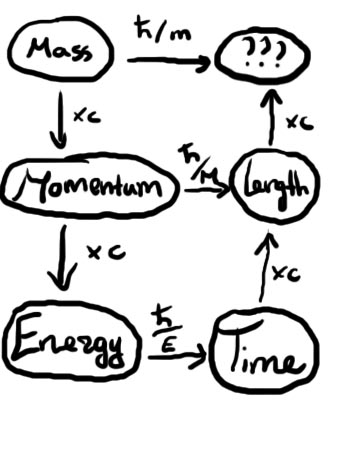Everyone can be a physicist for one day! So I was just playing around a bit with planck units, and put all the important units in a little table, figuring how I could convert one into the other.
If you take a planck mass (m), which is sqrt( red. planck constant (h) * speed of light (c) / Gravitational Constant (G) ): sqrt( h*c / G ), you can go to a planck momentum by multiplying by c, and to planck energy by again multiplying by c.
mass = m (= sqrt( h * c / G ))
momentum (M) = mc (= sqrt( h * c^3 / G ))
energy (E) = mcc = mc^2 (= sqrt( h * c^5 / G ))
We could also invert all of these equations by dividing reduced planck constant by the equation.
h/E = h / mc^2 = time (= sqrt( h * G / c^5 ))
h/M = h / mc = length (= sqrt( h * G / c^3 ))
h/m = h / m = ??? (= sqrt( h * G / c ))
This looks rather puzzling, but to me it's like Russian: look at it and it doesn't make sense, read it out loud and it starts to sound somewhat like English.
Mass seems to be defined as the amount of energy per square lightspeed (m = E/c^2) in the universe.
Momentum is the energy per lightspeed (M = E/c)
Energy is energy

(E = E).
Time is energy, but inverted with the reduced planck constant.
T = h/E. How many energy fits in a planck unit? This is apparently the value of time. Or if time is equal to 1 (we advance in time by 1 frame, no more or less), then there's x energy in one planck unit (seems the more sensible way to me).
Length is momentum inverted by h. L = h/M. If we multiply time by the lightspeed, we end up with length. S = v * t, or length = c * t. If you do the maths with time as h/sqrt(h*G/c^5), or "plancks per energy" (as derived from the planck mass equation), you end up with the planck-length equation, in terms of "plancks per momentum".
We could multiply with the light speed one more time, ending up with h/sqrt(h*G/c), "plancks per mass". But this equation has no name as far as I can find. Does the inverted mass have a physical meaning?
I drew a picture:

Inbetween are also alot of planck units, such as power, and force, and density, and volume, but they do not form the basic structure as I see it, they are just by-products.
Let me know what you think!